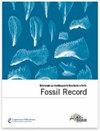Thomas A. Neubauer, Oleg Mandic, Mathias Harzhauser
下载PDF
{"title":"波黑东南部加科湖中新世淡水软体动物区系:分类修正与古环境分析","authors":"Thomas A. Neubauer, Oleg Mandic, Mathias Harzhauser","doi":"10.1002/mmng.201300003","DOIUrl":null,"url":null,"abstract":"<p>The early Middle Miocene Lake Gacko was part of the Dinaride Lake System (DLS) and gave rise to a poorly known freshwater mollusk fauna. This was subject to malacological studies from the late 19th century onwards. Herein, we provide the first thorough taxonomic survey of Lake Gacko including revisions of several taxa. A total amount of 1,077 specimens was obtained from 17 samples, comprising at least 11 freshwater and 2 terrestrial gastropod species and 6 bivalve species. So far, none of the described taxa has been documented outside the Dinarides and the DLS, respectively. The fauna shows variable overlap with other paleolakes of the DLS, proofing once more the complex biogeographic patchwork of this system. The current paleoenvironmental reconstructions are tested and refined by application of a statistical analysis. This confirms the partition of the sedimentary history of Lake Gacko into three major depositional phases responding to astronomically forced climate changes. The low diverse mollusk assemblage in the initial phase, with abundant pulmonate and rissooid gastropods, signals a more arid climate with lowered lake level. During the second interval, the fauna becomes more diverse with common rissooid and melanopsid gastropods. It represents a more humid interval with enhanced precipitation and increased lake level, entailing the installation of a perennial lacustrine environment. The final phase is a return to arid conditions with the same elements as in the initial pulmonate-rissooid assemblage. The sphaeriid <i>Pisidium vukovici</i> n. sp. is introduced as new species. (© 2013 WILEY-VCH Verlag GmbH & Co. KGaA, Weinheim)</p>","PeriodicalId":55147,"journal":{"name":"Fossil Record","volume":"16 1","pages":"77-96"},"PeriodicalIF":2.1000,"publicationDate":"2013-02-21","publicationTypes":"Journal Article","fieldsOfStudy":null,"isOpenAccess":false,"openAccessPdf":"https://sci-hub-pdf.com/10.1002/mmng.201300003","citationCount":"20","resultStr":"{\"title\":\"The Middle Miocene freshwater mollusk fauna of Lake Gacko (SE Bosnia and Herzegovina): taxonomic revision and paleoenvironmental analysis\",\"authors\":\"Thomas A. Neubauer, Oleg Mandic, Mathias Harzhauser\",\"doi\":\"10.1002/mmng.201300003\",\"DOIUrl\":null,\"url\":null,\"abstract\":\"<p>The early Middle Miocene Lake Gacko was part of the Dinaride Lake System (DLS) and gave rise to a poorly known freshwater mollusk fauna. This was subject to malacological studies from the late 19th century onwards. Herein, we provide the first thorough taxonomic survey of Lake Gacko including revisions of several taxa. A total amount of 1,077 specimens was obtained from 17 samples, comprising at least 11 freshwater and 2 terrestrial gastropod species and 6 bivalve species. So far, none of the described taxa has been documented outside the Dinarides and the DLS, respectively. The fauna shows variable overlap with other paleolakes of the DLS, proofing once more the complex biogeographic patchwork of this system. The current paleoenvironmental reconstructions are tested and refined by application of a statistical analysis. This confirms the partition of the sedimentary history of Lake Gacko into three major depositional phases responding to astronomically forced climate changes. The low diverse mollusk assemblage in the initial phase, with abundant pulmonate and rissooid gastropods, signals a more arid climate with lowered lake level. During the second interval, the fauna becomes more diverse with common rissooid and melanopsid gastropods. It represents a more humid interval with enhanced precipitation and increased lake level, entailing the installation of a perennial lacustrine environment. The final phase is a return to arid conditions with the same elements as in the initial pulmonate-rissooid assemblage. The sphaeriid <i>Pisidium vukovici</i> n. sp. is introduced as new species. (© 2013 WILEY-VCH Verlag GmbH & Co. KGaA, Weinheim)</p>\",\"PeriodicalId\":55147,\"journal\":{\"name\":\"Fossil Record\",\"volume\":\"16 1\",\"pages\":\"77-96\"},\"PeriodicalIF\":2.1000,\"publicationDate\":\"2013-02-21\",\"publicationTypes\":\"Journal Article\",\"fieldsOfStudy\":null,\"isOpenAccess\":false,\"openAccessPdf\":\"https://sci-hub-pdf.com/10.1002/mmng.201300003\",\"citationCount\":\"20\",\"resultStr\":null,\"platform\":\"Semanticscholar\",\"paperid\":null,\"PeriodicalName\":\"Fossil Record\",\"FirstCategoryId\":\"89\",\"ListUrlMain\":\"https://onlinelibrary.wiley.com/doi/10.1002/mmng.201300003\",\"RegionNum\":4,\"RegionCategory\":\"地球科学\",\"ArticlePicture\":[],\"TitleCN\":null,\"AbstractTextCN\":null,\"PMCID\":null,\"EPubDate\":\"\",\"PubModel\":\"\",\"JCR\":\"Q3\",\"JCRName\":\"Earth and Planetary Sciences\",\"Score\":null,\"Total\":0}","platform":"Semanticscholar","paperid":null,"PeriodicalName":"Fossil Record","FirstCategoryId":"89","ListUrlMain":"https://onlinelibrary.wiley.com/doi/10.1002/mmng.201300003","RegionNum":4,"RegionCategory":"地球科学","ArticlePicture":[],"TitleCN":null,"AbstractTextCN":null,"PMCID":null,"EPubDate":"","PubModel":"","JCR":"Q3","JCRName":"Earth and Planetary Sciences","Score":null,"Total":0}
引用次数: 20
引用
批量引用

 求助内容:
求助内容: 应助结果提醒方式:
应助结果提醒方式:


